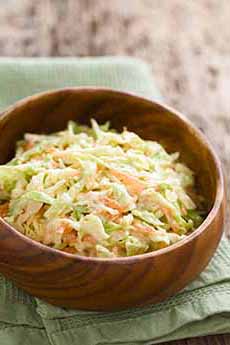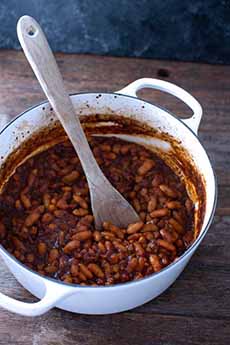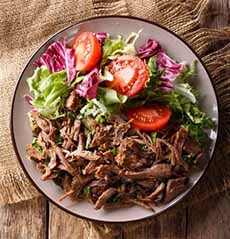Burnt Ends With BBQ Sauce, For National Barbecue Month
|
|
May is National Barbecue Month. Spell it barbecue, barbeque or the abbreviated BBQ‡, it’s a mandate to help yourself to some juicy grilled meat. As an apartment dweller with neither grill nor smoker (nor yard!), we’d love to enjoy an occasional barbecue dinner at home. Our only option instead was a BBQ restaurant. Until now. Sam’s Club’s Member’s Mark brand has recently introduced Burnt Ends, a Kansas-City style barbecued pork ends. (There’s more about the style and history of Kansas City Barbecue below, preceded by barbecue since the dawn of mankind.) You need neither grill nor smoker to enjoy this tasty barbecue: fully cooked, ready to heat and eat. What are burnt ends? They’re pieces of the crusty outer edges of a smoked brisket: a fatty, flavorful meat cut that’s juicy and tender on the inside (nothing is actually burned). Burnt ends are a hot cut in Kansas City, and Sam’s Club jumped on the trend. For Maker’s Mark, seasoned morsels of bite-size beef brisket are slow-smoked for 10 hours with a brown sugar and coffee rub. A package of classic tomato based Kansas City-style barbecue sauce is included with the two-pound package of beef. It’s the easiest way to enjoy smoky, crispy, tender little nuggets of barbecue at home—for $19.98, just 62 cents per ounce. The Member’s Mark Burnt Ends were developed for Sam’s Club by a four-time world champion pitmaster, Todd Johns of Plowboys Barbeque in Kansas City. The result: the highest-quality, most delicious, Kansas City-authentic product for Sam’s Club Members to enjoy. (Here’s a video showing how). The development team did such a good job, that Burnt Ends earned a seal of approval from The Kansas City Barbeque Society (and a two-thumbs-up from THE NIBBLE). While drying meat in the sun is the oldest method of preserving it (it creates jerky), a smoky fire keeps insects away from the meat, further helping in the preservation. About about 1.8 million years ago, Homo erectus, an predecessor of Homo sapiens (that’s us!) discovered how to make fire and began cooking their meat over or on it. They dug a pit for the wood or other fuel, and cooked over the fire. Homo erectus emerged 1.5 to 1.9 million years ago. By the time Homo sapiens emerged some 315,000 years ago, man had been enjoying barbecue and jerky for thousands of centuries [source]. Big leap forward: Prior to the relatively recent debut of home refrigeration in the 1930s (the first ice boxes arrived in 1915, affordable by few people), meat from slaughtered animals had to be either cooked and eaten promptly, or preserved by either salting or smoking. Over the centuries, in what are now the southern United States, smoking evolved into what we now call southern-style barbecue. There are many styles of barbecue around the world. American barbecue has evolved to use chicken, pork, or sometimes, beef, covered in a sweetened sauce and then grilled. Our word barbecue derives from the Spanish adaptation of barbacoa, from the language of a Caribbean tribe called the Taino. Their barbacoa was a raised wooden grate over a fire of wood or charcoal, where meat was grilled. Spanish explorers observed the technique, and the word first appeared in print in 1526, in an account of the West Indies [source]. As the practice evolved, the wooden racks of the Taino were replaced with pits and smoke houses†. The modern backyard barbecue grill evolved for homemade barbecue. While the ancient pit barbecue is still a tradition†, most Americans barbecue over a backyard grill, with spices and basting sauces—not from the cooking traditions of ancient man, but from recipe origins in the Caribbean. Kansas City barbecue is characterized by its use of a wide variety of meats: pork, beef, chicken, turkey, lamb, sausage, and sometimes even fish. The specific regional style of slowly smoked meat originated in 1908, in the pit barbecue restaurant of Henry Perry in Kansas City, Missouri. An African American from Tennesee, he operated his business out of a trolley barn in the legendary African-American neighborhood around 18th and Vine. The restaurant is still open in another location in the neighborhood. It is called Arthur Bryant’s, after the employee who took over the restaurant in 1946. Kansas City barbecue is rubbed with spices, slow-smoked over a variety of woods and served with a thick tomato-based barbecue sauce, most commonly sweetened with molasses (most local restaurants and sauce companies offer several varieties with sweet, spicy and tangy flavor profiles) [source]. |
|
|
________________ *In the millennia before the invention of the mechanical ice box, people kept food cold with ice and snow, saved during the winter months or brought down from mountaintops. The first “refrigeration” consisted of a hole dug into the ground and lined with wood or straw. It was then packed with snow and ice. Ice boxes existed from the mid-19th century, a response to the ice harvesting industry in America. The devices had hollow walls that were lined with tin or zinc and packed with insulation (cork, sawdust, straw, e.g.). A large block of ice was placed in a compartment near the top of the box, enabling cold air to circulate down into the storage compartment(s) below. Fresh ice was delivered by an iceman. While commercial refrigeration was available by the late 1800s, the home electric refrigerator didn’t arrive until 1930. †What Southerners consider “real barbecue” is still cooked in a traditional open pit, not in a smoker. A whole hog is cooked over direct heat from charcoal, sometimes with wood added. ‡As of today’s publication date, BBQ has 603,000,000 in Google; barbecue has 176,000,000 and barbecue 48,500,000 searches. |
||






